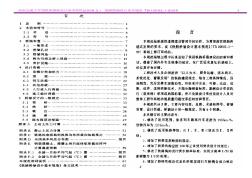铁路桥涵设计规范(TB10002-2017 英文版)图书目录
1 General Provisions
2 Terms and Symbols
2.1 Terms
2.2 Symbols
3 Layout of Bridge and Culvert
3.1 General Requirements
3.2 Aperture of Bridge and Culvert
3.3 Structure of Bridge and Culvert
3.4 Bridge Approach and Tracks on the Bridge
3.5 Deck Layout and Ancillary Facilities
3.6 Maintenance and Repair Facilities
3.7 Structural Design and Safety Protection of Crossing Railway Bridge
3.8 Bridge Structure of Elevated Station
3.9 System Interface Design
4 Design Loads
4.1 Load Classification and Combination
4.2 Dead Loads
4.3 Live Loads
4.4 Other Loads
4.5 Service Passageway Loads and Railing Loads
4.6 Construction Loads
5 Design of Bridge and Culvert
5.1 General Requirements
5.2 Beam Bridge
5.3 Arch Bridge
5.4 Pierand Abutment
5.5 Culvert
5.6 Jacking Bridge and Culvert
Appendix A Active Earth Pressure Calculation
Appendix B Static Earth Pressure Calculation
Appendix C Distribution Diagram of Reference Wind Pressure in China
Appendix D Illustration of Calculating Temperature of Rectangular Section Members of Reinforced Concrete, Concrete and Stone Masonry
Appendix E.1 Average Air Temperature (oC) in January in China
Appendix E.2 Average Air Temperature (oC) in July in China
Words Used for Different Degrees of Strictness2100433B
铁路桥涵设计规范(TB10002-2017 英文版)造价信息
Since the issuance of Fundamental Code for Design on RaiLway Bridge and Culvert (TB 10002. 1-2005) , China has made remarkable achievements in railway construction, in particular high-speed railway ( HSR) . High-speed railways like Beijing-Shanghai HSR, Beijing-Guangzhou HSR,Zhengzhou-Xi'an HSR and Harbin-Dalian HSR,mixed passenger and freight railways like Yichang-Wanzhou Railway and Taiyuan-Zhongwei-Yinchuan Railway, heavy-haul railways like Central and Southern Shanxi Railway and Mengxi-Huazhong Railway, intercity railways like the Pearl River Delta Intercity Railway and Wuhan Metropolitan Circle Intercity Railway have been completed and opened to traffic,improving the railway network structure and increasing the effective supply of railway transportation services. After more than ten years of exploration and innovation, China has made a historic breakthrough and achieved a momentous leap in the construction technology of railway bridges, reaching the world's high level. A number of deep-water and long-span bridges,complex bridges,and bridges in special geological conditions,such as Nanjing Dashengguan Yangtze River Bridge and Wuhan Tianxingzhou Yangtze River Bridge,have been completed successfully and the complete sets of large-tonnage box beam technology researched and developed independently by China have been widely used9 accumulating rich experience and laying a solid foundation for further improving the technical standards of railway bridge.
This Code is prepared according to the requirements of establishing the railway engineering and construction standard system of National Railway Administration and based on the revision of Fundamental Code for Design of Railway Bridge and Culvert (TB 10002.1-2005), by summarizing the experience and scientific research results in the construction and operation of bridges and culverts of Fugh-speed railways, interaty railways,mixed passenger and freight railways and heavy-haul railways in China, with a view to meeting the demand for the construction and development,unifying the design standards,improving the design level and ensuring the safety and quality of railway bridges and culverts.
In this Code, the principleof safety first is implemented and the technical requirements for quality safety, resource conservation9 environmental protection, risk prevention, and disaster prevention and mitigation are strengthened.The main design criteria for railway bridges for different services and different speed levels are determined rationally in consideration of the national situation, the economic and social development level and environmental conditions of China,further improving the scientificity and technical and economic rationality in terms of bridge and culvert design.
This Code consists of 5 chapters,namely General Provisions,Terms and Symbols,Layout of Bridge and Culvert,Design Loads and Design of Bridge and Culvert,and 5 appendices.
铁路桥涵设计规范(TB10002-2017 英文版)图书目录常见问题
-
http://www.gougou.com/search?search=%e9%93%81%e8%b7%af%e6%a1%a5%e6%b6%b5%e6%96%bd%e5%b7%a5%e8%a7%84%...
-
巧妇难为无米之炊,没有TB 10203-2011从何而求?不信可以到官网查询。
-
《TB10203-2002铁路桥涵施工规范》已被铁建设(2009)23号文废止。铁道部文件铁建设〔2009〕23号关于废止铁路路基施工规范等26项铁路工程建设标准的通知各铁路局,投资公司,各铁路公司(...
铁路桥涵设计规范(TB10002-2017 英文版)图书目录文献

 铁路桥涵设计基本规范TB10002D1-2005 (2)
铁路桥涵设计基本规范TB10002D1-2005 (2)
铁路桥涵设计基本规范TB10002D1-2005 (2)

 铁路桥涵设计基本规范TB10002D1-2005
铁路桥涵设计基本规范TB10002D1-2005
铁路桥涵设计基本规范TB10002D1-2005
内容简介
《DL/T 51952004 英文版》为Specification for Design“水工隧洞设计规范(DL/T 5195-2004)(英文版)”。《DL/T 51952004 英文版》由中国电力出版社编著。2100433B
内容简介
《住宅设计规范 GB50096-2011(英文版)》,本书为《住宅设计规范》GB 50096-2011的英译本。主要内容包括:总则,术语,基本规定,技术经济指标计算,套内空间,共用部分,室内环境,建筑设备。本规范经住房和城乡建设部以第1093号公告批准发布,自2012年8月1日起实施。原《住宅设计规范》GB 50096-1999(2003版)同时废止。
2100433B
内容简介
《连铸工程设计规范(英文版 GB 50580-2010)》为中华人民共和国国家标准,由住房城乡建设部组织翻译的英文版,用于对外交流和国内对外的合作。中文版已于2012年出版。本规范由中华人民共和国住房和城乡建设部第1264号公告批准,编号为GB50754-2012,自2012年8月1日起实施。其中4条(款)为强制性条文,必须严格执行。
本规范适用于新建、改建和扩建的挤压钢管工程设计。共分12章,主要技术内容包括:总则,术语,基本规定,原料,生产工艺,设备,生产能力计算,平面布置和车间设计,电气自动化,公辅系统,主要技术经济指标,安全与环保等。 2100433B
- 相关百科
- 相关知识
- 相关专栏
- 铁路桥涵
- 铁路桥隧工:应知应会知识问答
- 铁路桥隧病害案例图库
- 铁路桥隧维修管理手册
- 铁路沿线人员安全必读/铁路安全管理条例宣贯丛书
- 铁路测量(第二版)
- 铁路测量
- 《铁路测量》中国铁道出版社出版图书
- 《铁路测量》
- 铁路消防安全培训教材
- 铁路消防安全知识
- 铁路消防安全
- 铁路消防管理办法
- 铁路液压捣固机和液压道岔捣固机通用技术条件
- 铁路混凝土
- 铁路混凝土梁支架法现浇施工技术规程
- 中国建筑抗震设计规范的演变与展望
- 在小桥涵软基处理中如何运用预应力混凝土管桩的分析
- 中国水泥工厂余热发电设计规范国家标准即将出台
- 宜万铁路鲁竹坝2号隧道的主要工程问题及其处理措施
- 中东铁路宽城子车站历史文化街区保护与更新策略
- 在32‰大坡道地段架设铁路T梁施工工艺及技术
- 永煤矿区铁路道口栏门自动联锁控制电路技改方案
- 中国高速铁路接触网施工技术与验收标准及及注意事项
- 原油和天然气输送管道穿跨越工程设计规范跨越工程.
- 应用水泥土挤密桩加固既有提速铁路路基基床施工技术
- 中川铁路饱和黄土地基水泥土搅拌桩静载试验
- 在铁路复杂咽喉区顶进大孔径框架桥设计施工关键技术
- 增加托架法在铁路桥梁大宽度人行道托架加固中的应用
- 宜万铁路八字岭隧道施工期岩溶突水灾害超前预报
- 中国铁路物资长沙钢铁有限公司赴衡钢、安钢走访调研
- 中、美混凝土结构设计规范正截面受弯承载力计算对比